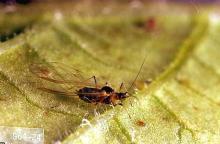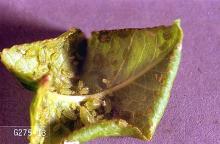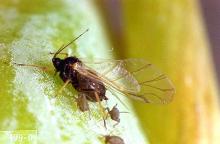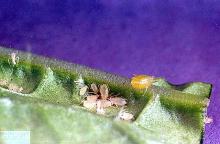Black bean aphid (Aphis fabae)
Green peach aphid (Myzus persicae)
Pest description and crop damage The black bean aphid is a dark-bodied aphid, 0.0625 inch long, that sporadically reaches damaging levels, most often late in the season. Infestations usually occur as scattered hot spots or along edges rather than uniformly across the entire field. Colonies can produce massive amounts of honeydew, which causes a black, sooty mold to cover the leaves. Black bean aphids can also vector virus diseases, but they are less important as virus vectors than green peach aphids.
The green peach aphid is yellow-green and teardrop-shaped. Its economic impact is primarily as a vector of virus diseases rather than by feeding injury through sucking sap. Green peach aphids are usually not as abundant on sugar beet as black bean aphids.
Scouting and thresholds No formal economic thresholds exist for green peach aphid insecticide treatment decisions. If natural enemies are absent, consider an insecticide application if bean aphids are on most leaves and if colonies cover 20 to 40 percent of leaf surface. If natural enemies are present and aphid populations are relatively low, monitor closely to evaluate effectiveness of natural enemies before spraying.
Management-biological control
Aphids are attacked by a large variety of predatory and parasitic insects as well as by fungal diseases. We do not yet know enough about arthropod natural enemies to suggest practical ways of manipulating and enhancing their effects other than avoiding any unnecessary insecticide applications. See Table 3 for commercially formulated biological products.
Management-chemical control
At-plant insecticides (Table 1) may only suppress aphids given that they usually occur late season when the level of active ingredients of at-plant products may have diminished. Pyrethroid (Group 3A) applications may make aphid management more difficult by eliminating aphid predators and parasitoids.




